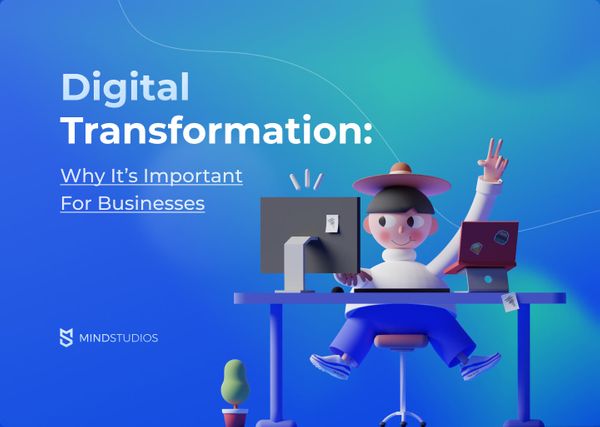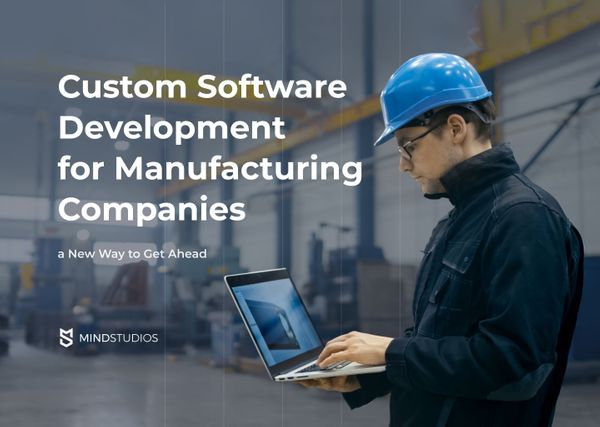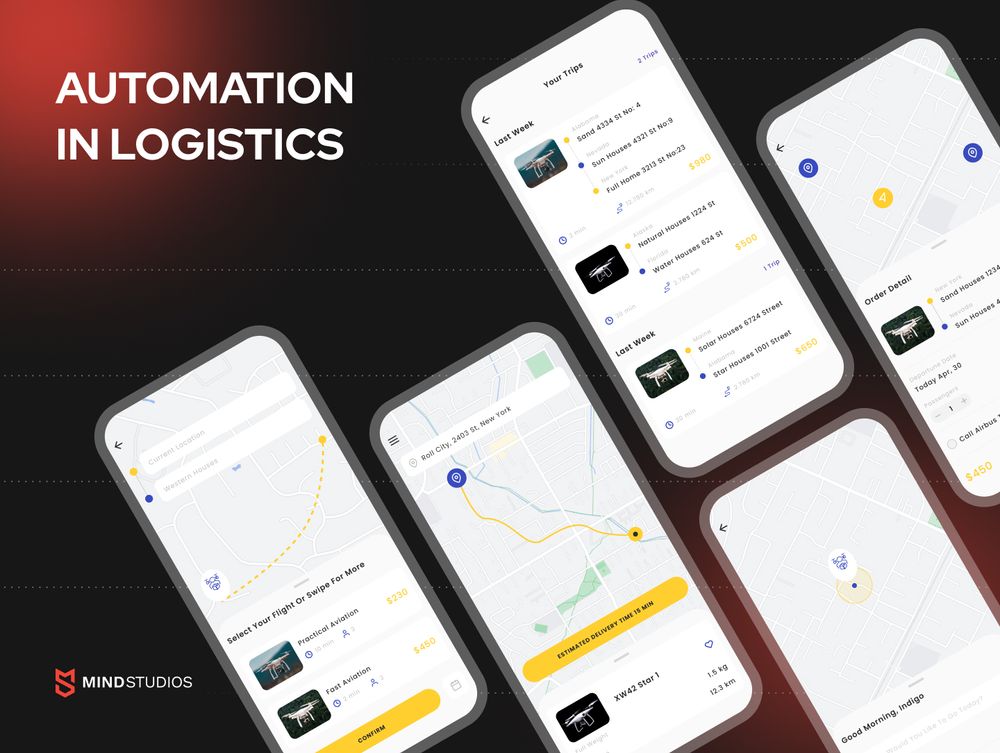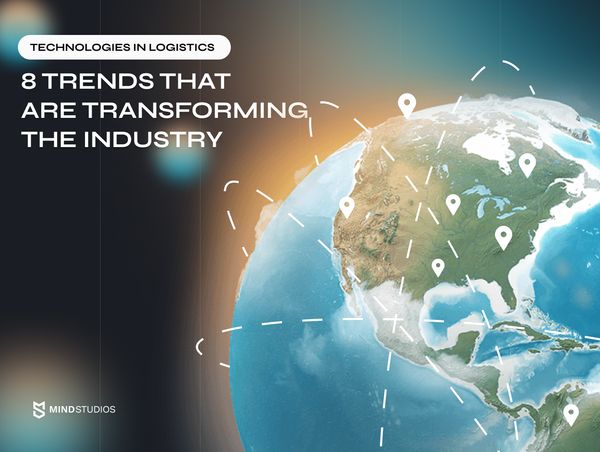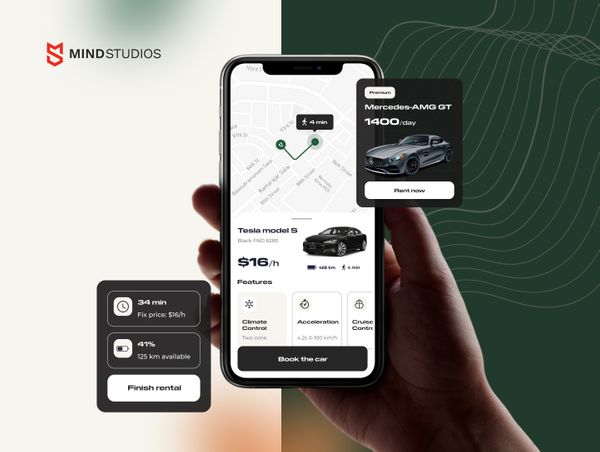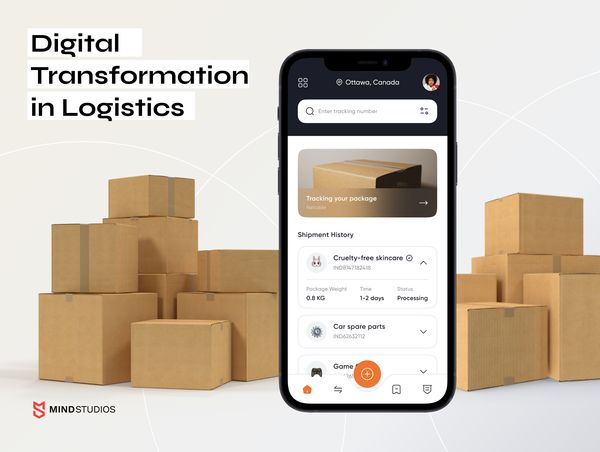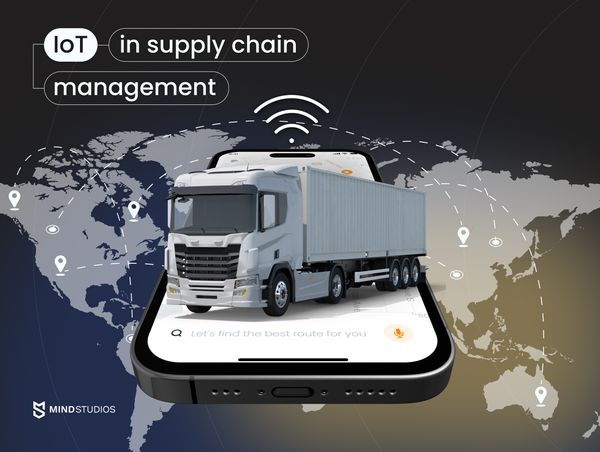
In 2023, the parcels are being delivered by drones and self-driving cars, each item produced at the factory is easily tracked in real time, and the demand for various goods is calculated with utmost precision. And it's all possible thanks to supply chain management using IoT.
The global market of IoT in logistics and supply chains is thriving: by 2028, it is expected to reach the value of USD 93.85 billion. However, many still view IoT as something primarily used by corporations like Amazon and Alibaba. So, can a small or medium-sized company that deals with supply chain management benefit from using IoT technology? And if so, how exactly would it work?
As a company that builds software solutions for the logistics industry, Mind Studios is constantly exploring how different businesses use IoT to enhance their operational efficiency.
Based on this research, we’ve made a guide on how you can integrate IoT into your day-to-day operations connected to chain supply management, and strengthen your business.
Key things for understanding IoT in supply chain
If you’re reading this article, chances are, you’ve heard that IoT technology in the supply chain can facilitate transparency and improve business performance. But how does it work exactly? And how can it help your operations in particular?
To get an in-depth understanding of how IoT is influencing supply chain management, you need to look beyond individual devices and sensors and take a look at the bigger picture.
Supply chain management process involves multiple complicated steps, logistics-wise: from supplying raw materials to manufacturing and sending the finished products to retailers. IoT technologies are aimed at making this journey more transparent — and thus more efficient, both operationally and strategically. Here is how it works.
Tasks IoT in supply chain management helps with
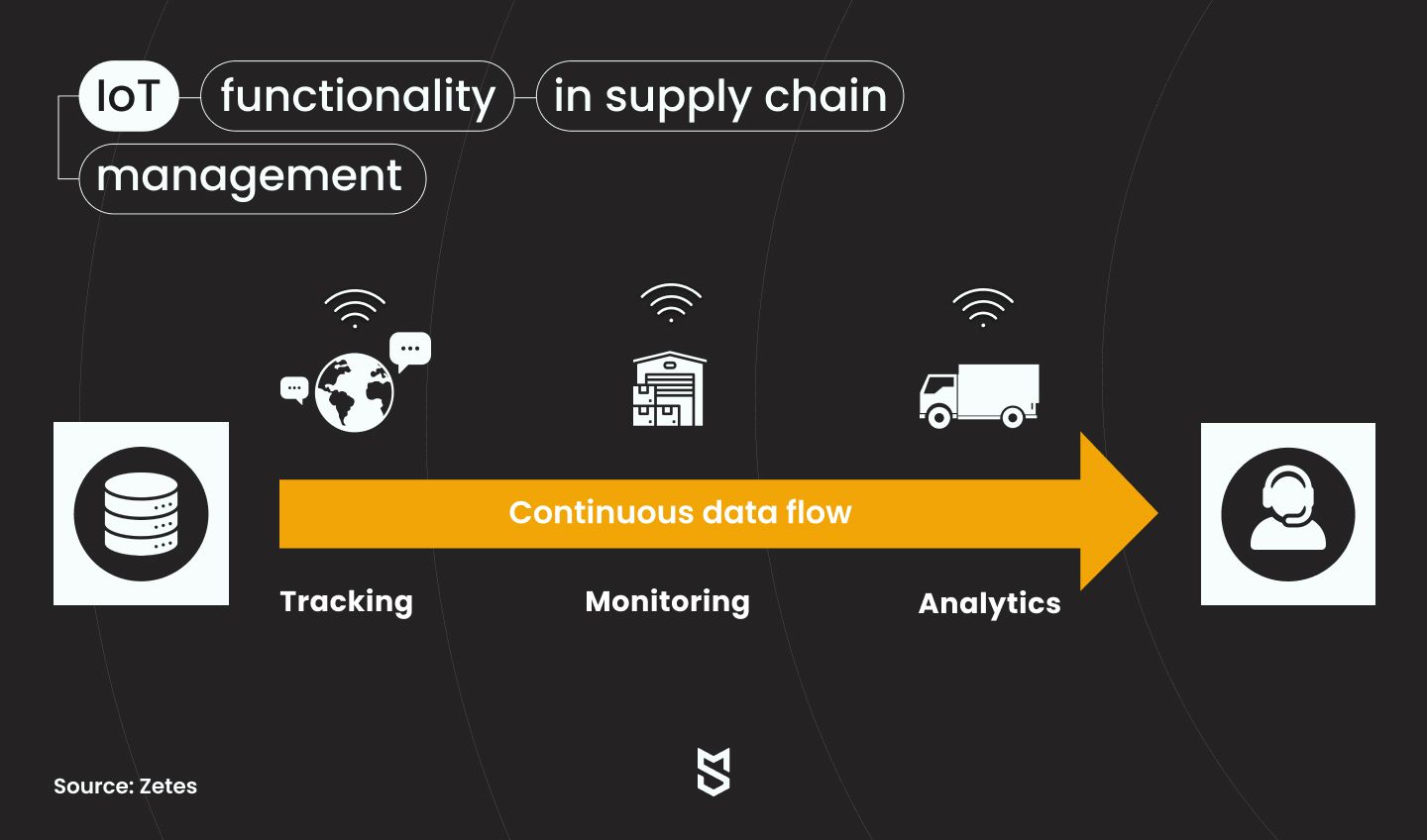
To put it simply, supply chain management using IoT involves using various sensors and IoT devices to gather and store information about goods. This data can be used to simplify day-to-day operations and even make informed business decisions.
By using the internet of things (IoT), supply chain managers can efficiently:
- Track the real-time location of the goods
- Locate items in the warehouse
- Optimize inventory control
- Determine the speed of goods’ movement to know the approximate time of arrival
- Monitor storage conditions, like temperature, humidity, pressure, etc.
- Control the quality of raw materials and productions through IoT scanners
- Conduct contingency planning
- Forecast customer demand more accurately
- Minimize losses by sending real-time alerts when something goes wrong
- Automate entire warehouse operations when used in combination with machine learning and AI technologies
- Deal with post-arrival administrative tasks like quality inspections
- Manage paperwork tasks like processing bills of lading
These functions of the Internet of Things in supply chain management are becoming more and more convincing for small businesses to use the technologies alongside big global companies. More on that in the next section.
Why integrate IoT into supply chain processes
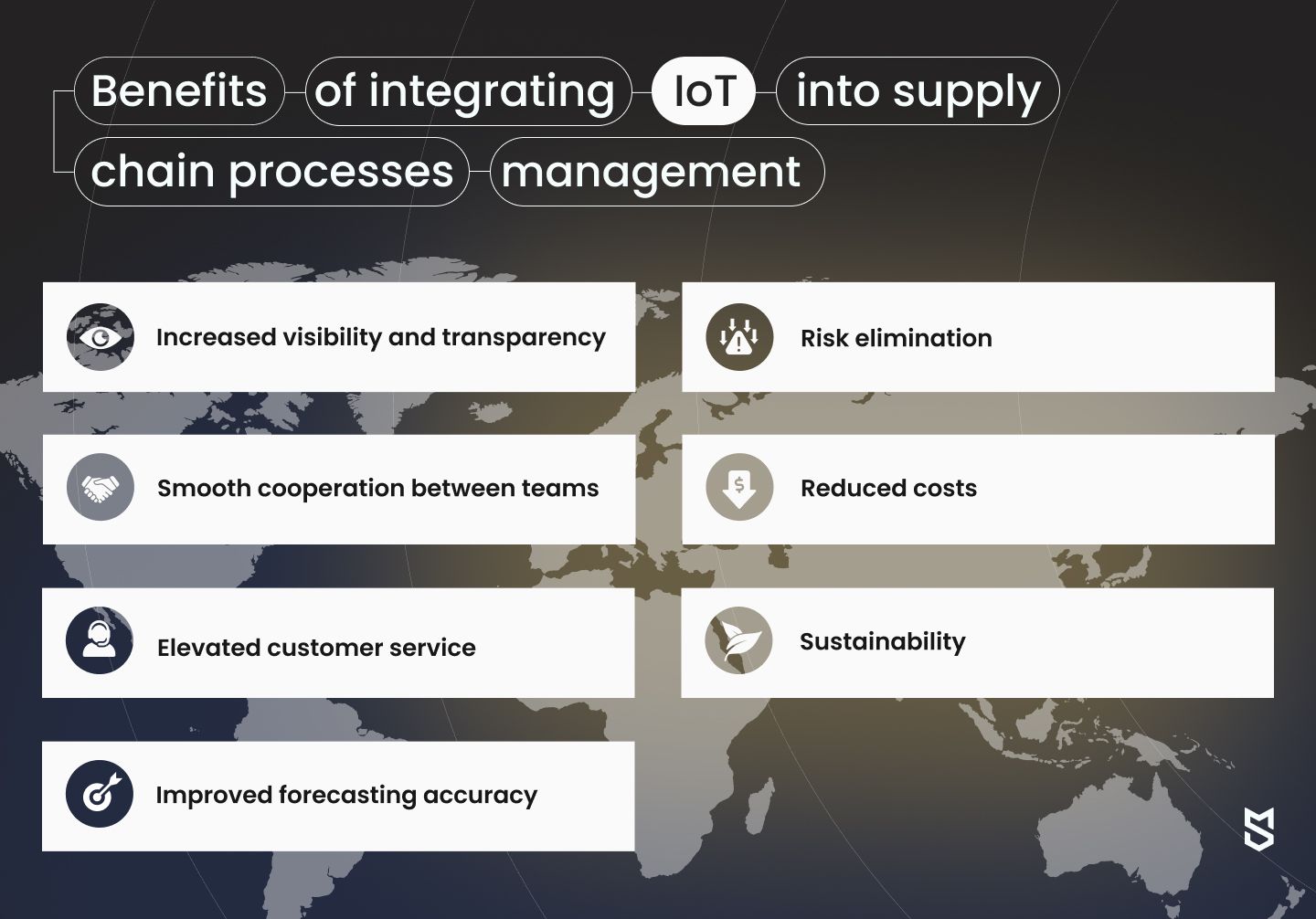
Integrating IoT into supply chain management processes can be a costly investment. And although we know how it helps tackle day-to-day operations, is it worth it money-wise for achieving strategic goals? Let’s look at the most significant advantages of IoT supply chain managers can benefit from in the long run.
Increased visibility and transparency
Using IoT across all stages of the supply chain management process helps all parties involved have a clear picture of the product’s journey: from collecting raw materials to delivering the finished goods to retail locations. This helps ensure that the whole cycle is time and cost-efficient, as well as control the quality of the products.
For businesses dealing with supply chains, IoT also simplifies the task of implementing their strategic goals and reporting the results to the stakeholders.
Let’s say, a cosmetics brand is set to be environmentally responsible and cruelty-free. To do so, it will have to control the full lifecycle of its products. And IoT is what can collect relevant data during the production and delivery stages — and thus help the brand commit to the set goals.
Smooth cooperation between teams
Supply chain cycle involves multiple parties: manufacturers, delivery providers, warehouse managers, and more. Therefore, when different teams operate different data sources, bottlenecks happen and damage the efficiency of the entire process.
With IoT solutions for logistics and supply chain management, these parties can build a unified system based on the same cloud & data analytics services and thus have access to accurate information in real time while avoiding inconsistencies and delays.
Also, let's take a look at the bigger picture. IoT eliminates human errors when it comes to analyzing data, helping stakeholders improve their long-term strategies, and making the decision-making process more efficient.
Elevated customer service
One of the most groundbreaking influences IoT has on customer service is the ability it gives retailers to forecast the exact delivery time of the products. Even if there are any obstacles, the managers can instantly find out about the delays and manage customer expectations accordingly.
In addition to timely delivery, IoT in supply chain management also helps retailers control the quality of the products they deliver to customers. If, for example, a perishable product wasn’t transported or stored under proper conditions — the IoT sensors would detect it, and the product won’t end up on the shelves.
Improved forecasting accuracy
Supply chain managers use IoT for demand forecasting and predictive analytics through historical and real-time data.
To give you an example, in combination with AI, IoT in supply chain management assists with establishing a proper flow of goods on production sites and in warehouses. This helps prevent overstocking and understocking, which could otherwise lead to unnecessary expenses and production or delivery delays.
Risk elimination
The main task of IoT is to collect data, and naturally, this data can be used for contingency planning and preventing various bottlenecks by analyzing the reasons for them happening. For instance, managers can determine whether shipment delays happened due to weather conditions, traffic, or truck malfunction — and take these factors into account next time.
One of the vivid examples of IoT in supply chain management is FedEx. This transportation company uses cloud solutions that receive data from the fleet and creates the most time and cost-efficient routes possible based on weather forecasts, traffic, and other real-time data from other sources.
Reduced costs
While at first IoT in chain management might seem like a significant investment, especially for a small business, in the long run, it most definitely does help business owners save money.
To name a few examples, improving route planning through IoT helps save on fuel and avoid delays, IoT-based proactive maintenance helps prevent major repairs, and predictive analytics using data collected by IoT helps establish an efficient stock flow.
Sustainability
If you’ve been thinking of implementing a green strategy into your business for a while — IoT can be the first step in that direction.
Internet of Things sensors are often used to inform managers of how energy and resources are used during different stages of the supply chain. This helps executives make an informed decision regarding the choice of renewable sources of energy, switching to electric vehicles, and more.
DHL, one of the biggest logistics companies in the world, has made significant progress in this area. The company uses smart heating, ventilation, and air-conditioning systems based on IoT sensors to adjust conditions in their facilities depending on current weather conditions, building occupancy, and other factors.
IoT in supply chain examples
Supply chains are rife with examples of the Internet of Things at work. Let's examine some existing examples and the businesses that created them.
-
FedEx: One of the vivid examples of IoT in supply chain management is FedEx. This transportation company uses cloud solutions that receive data from the fleet and create the most time and cost-efficient routes possible based on weather forecasts, traffic, and other real-time data from other sources.
-
Maersk: Maersk is a Danish shipping business that accounts for 18% of worldwide container commerce. The business created the Remote Container Management (RCM) system, which monitors the status of 300,000 refrigerated containers. RCM offers excellent transportation conditions and decreases the possibility of products spoiling due to precise temperature and humidity management.
Furthermore, having complete insight into container conditions enables Maersk to decrease the cost and time required for inspection upon arrival, since inspection companies receive access to data indicating that containers were carried in excellent condition.
-
Aker: The Aker company illustrates how a raw material supplier might profit from IoT adoption. Aker offers proactive, real-time deep crop surveillance to reduce production loss. The IoT system employs drones, a network of 3D video sensors, big data technologies, and machine learning, enabling farmers to recognise crop damage caused by insects, disease, and other causes and make critical choices more quickly.
-
DHL: DHL and its partner created a custom, low-profile sensor to detect roller cages inside and between DHL facilities. Sensors have low power consumption and a battery that can hold a charge for 15 years. Operators then use sensor data to decrease shrinkage via a cloud-based management platform.
DHL saves 40% on energy costs thanks to another IoT effort. Using innovative heating, ventilation, and air-conditioning, the system adjusts set points in real time depending on predicted weather conditions, building occupancy, and business activity, all while keeping facility temperatures within a chosen operating range.
How IoT for the supply chain is used in various industry sectors
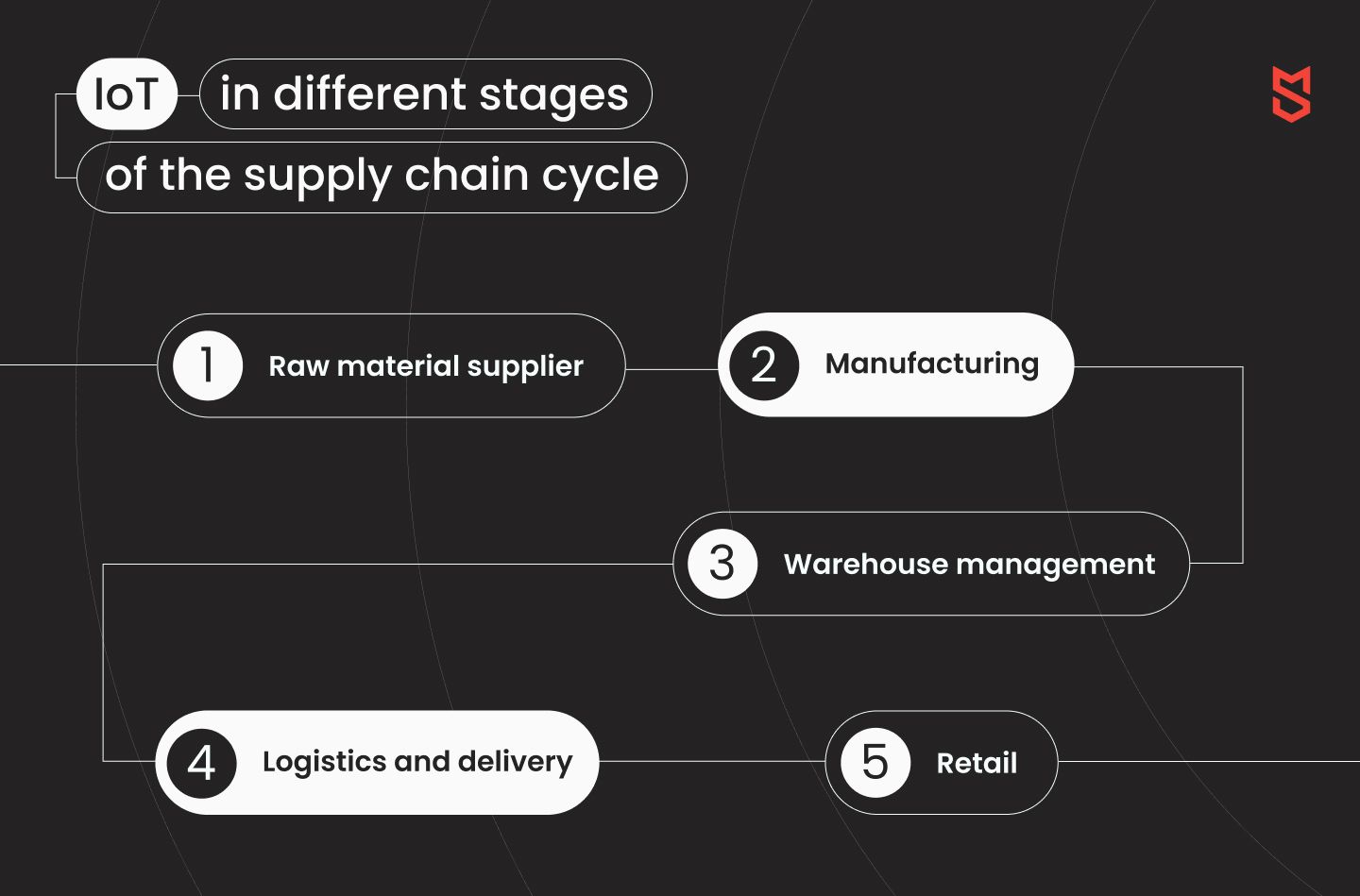
A supply chain is a complex system involving multiple stages, from producing raw materials to handing the finished product to the end customer. And across all these stages, Internet of Things technologies can be beneficial. Here are the five core IoT use cases for the supply chain.
Raw material supplier
While in general, IoT is more widespread in the next stages of the supply chain system, the use of various devices is gaining more popularity in the agricultural sector. For instance, IoT drones, robots, and sensors are often used on farms to measure the chemical composition of the soil, monitor crops and livestock, map fields, and perform other tasks.
In the future, as robots become more advanced and accessible at the same time, there will be more use cases for IoT solutions used by raw material suppliers.
Manufacturing
IoT systems in manufacturing help managers monitor the production process and detect any bottlenecks that cost the business money. Also, Internet of Things sensors assist with catching resource leaks and alerting of any machine crashes.
To go even further, IoT technology can be used to continuously analyze the machines’ performance, prevent critical breakdowns, and therefore avoid urgent, expensive repairs.
IoT chain management systems can be used not only to improve the production process but to enhance the products as well. To give you an example, Volvo, an automotive manufacturer, uses IoT sensors for proactive maintenance. The company has placed IoT sensors in its trucks, which helped reduce diagnostic time by 70% and truck repair time by 25%.
Last but not least, the Internet of Things in manufacturing helps businesses be more sustainable. IoT devices assist in controlling the use of water at manufacturing plants, producing less waste and utilizing it in the least harmful way, and tracking pollution.
Warehouse management
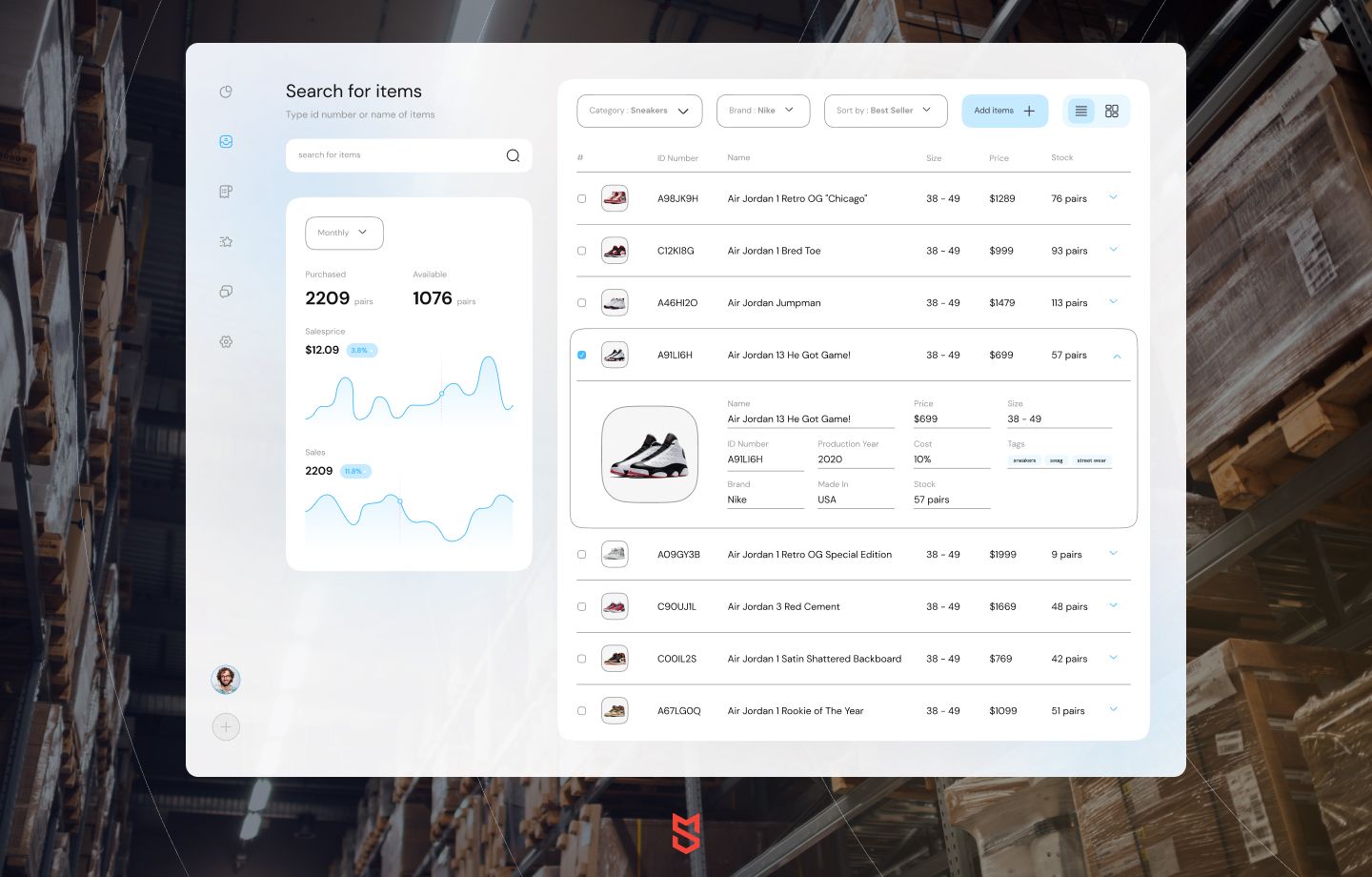
The main point of using IoT sensors for goods stored in warehouses is to establish an effective real-time inventory tracking system. Through the RFID (radio frequency identification) sensors, warehouses keep track of inventory items, stock levels, new arrivals, changes to storage conditions, and more.
Internet of Things sensors in the warehouse management can also be used in combination with smart glasses to increase picking performance and reduce the time required for completing orders.
Some companies that manage big storage spaces use Autonomous Mobile Robots (AMR) with proximity sensors and cameras to completely automate warehouse operations. AMR can analyze and easily navigate around the storage space. Amazon, for example, uses over 500,000 robots to help their workers carry shelves and packages, as well as scan barcode labels and perform other tasks.
Logistics and delivery
One of the key participants of the IoT supply chain management are the distributors responsible for the delivery of goods. They use IoT technology to provide their partners with real-time data on product locations and approximate time of arrival, as well as inform them of any delays.
What is more, by analyzing delivery routes, distributors can optimize them to cut costs in the future, especially if deliveries are done by several means of transportation.
IoT also helps make the delivery process more transparent. For instance, by using RFID tags the distributors can track every single item that is being delivered and make sure nothing is lost.
Monitoring storage conditions for certain products can also be of critical importance. Did you know that IoT played a crucial role in the pandemic? Since the vaccines for COVID-19 are highly temperature-sensitive, they required special conditions during the whole delivery process. DHL, a global logistics company, managed to deliver more than a billion doses of those vaccines to 160 countries by maintaining safe storage conditions through IoT sensors.
Retail
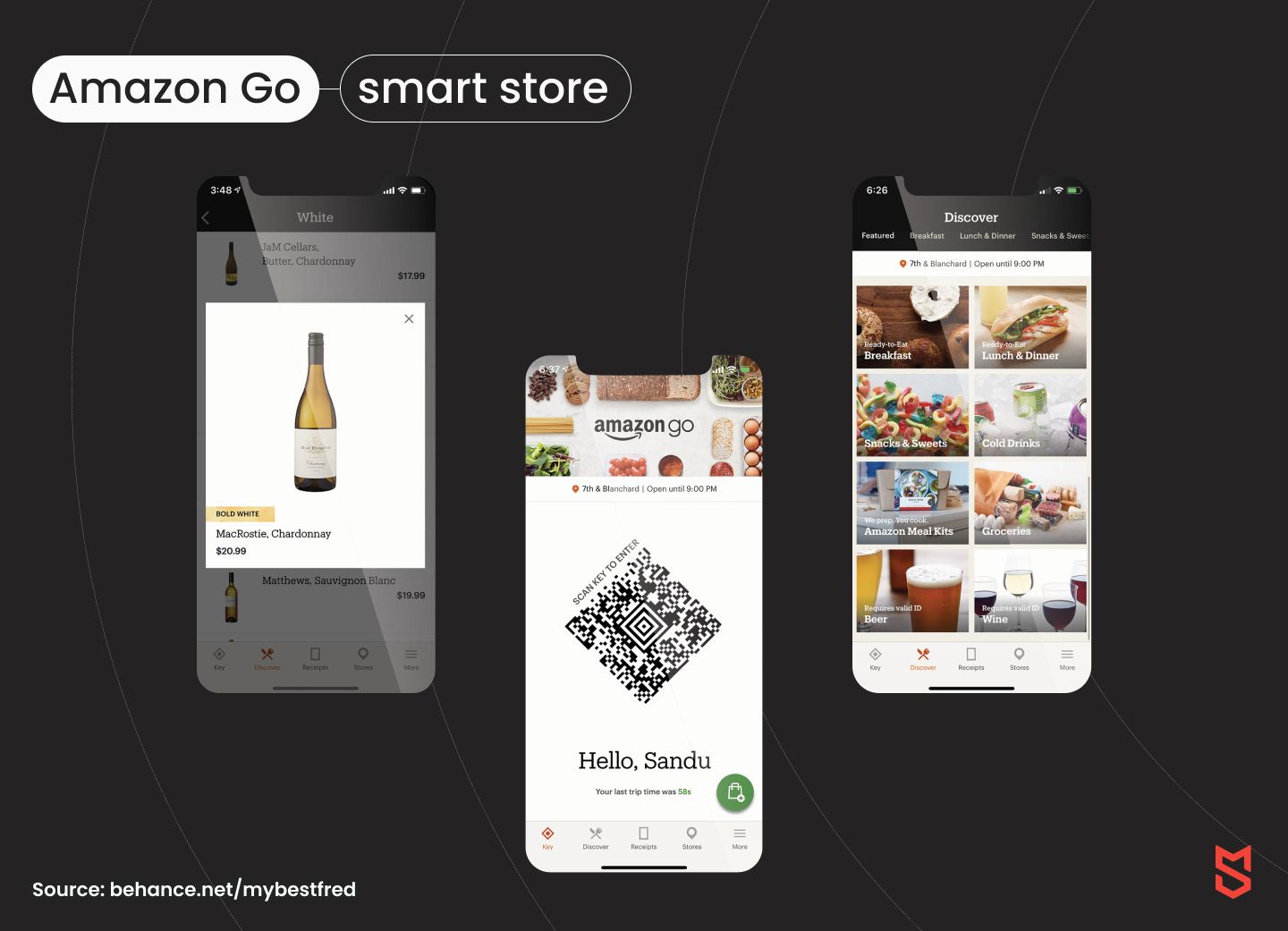
[Source: Behance]
Just as with IoT warehouse management, Internet of Things sensors help speed up the process of loading and unloading goods in retail locations. But there is more to that.
IoT brings the offline shopping experience to a whole new level, where customers don’t have to wait in lines or even use self-checkouts. Through the use of sensors, stores can identify the products customers pick in the store, add them to their shopping cart in an app, and withdraw the final cost from their account once they leave with the purchased items.
Challenges faced by IoT in supply chain management
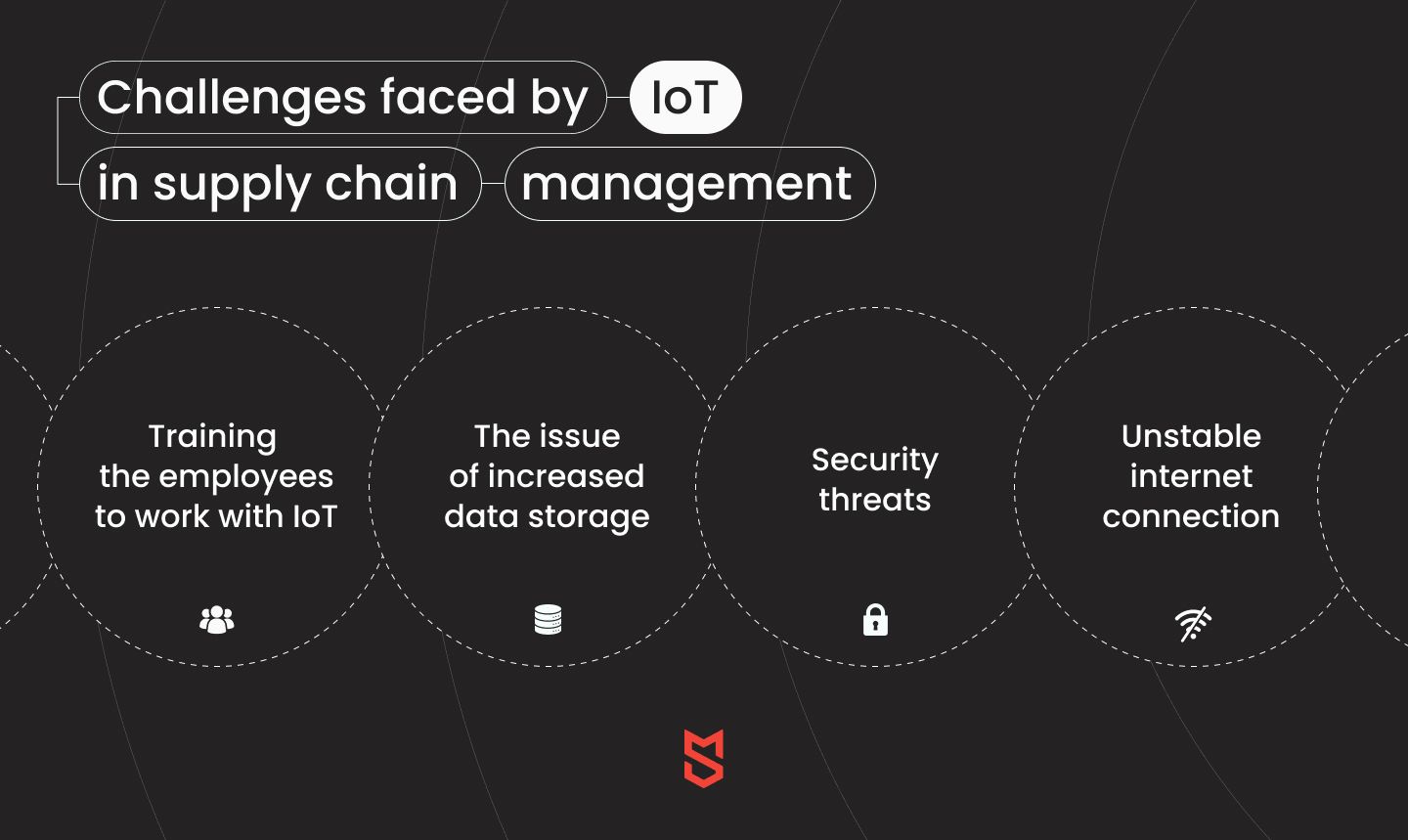
As it usually happens, the implementation of new technologies also comes with certain challenges businesses need to be ready for. Here are some of the most pressing ones regarding IoT for logistics and supply chain management.
Training the employees to work with IoT
In the long run, automating supply chain processes saves businesses money. However, for successful implementation, they also need to invest in adequate training of their employees (warehouse workers, drivers, etc.) since they will be the ones who operate the new gadgets and work with the IoT systems.
Training the workers, not to mention establishing new security and workflow guidelines, can be a very time-consuming process.
The issue of increased data storage
The fact that the Internet of Things in supply chain management collects enormous amounts of data is both an upside and a downside. While it is extremely helpful to the managers, it also requires a solution with enough server power to store and quickly process all that information.
To deal with these issues, companies that want to integrate IoT into their day-to-day operations need to develop data governance policies and collaborate with data scientists and analysts to learn how to work with information collected by Internet of Things devices. Big Data solutions might also be helpful in this case.
Security threats
When dealing with data storage and processing, strong data protection must be one of the top priorities for business owners if they want to avoid cyberattacks, leaks, and damage to the reputation of the company that comes along.
To eliminate security threads, you need to choose a reliable services provider who can help you implement cryptographic hardware monitoring practices, integrate solid cloud storage solutions, and advise on other cybersecurity measures.
Unstable internet connection
To work properly, IoT systems need to stay connected to the internet. However, during the delivery phase, it can be quite unreliable, especially when the goods are transported through geographical locations where 5G coverage isn’t available.
While with transportation the only thing you can do is wait, in warehouses, manufacturing plants, and retail locations it’s easy to avoid internet connection disruptions and ensure continuous data collection.
Mind Studios & IoT supply chain development
So, what comes after you make up your mind about integrating IoT-based supply chain management systems? To make the implementation successful, you need to invest not only in the IoT devices themselves but also in software that will effectively process and use the data collected from those devices.
Basically, to go through with the idea, you will need to partner up with a software development company that can build you a custom solution to match your business needs perfectly. And that’s where Mind Studios comes in.
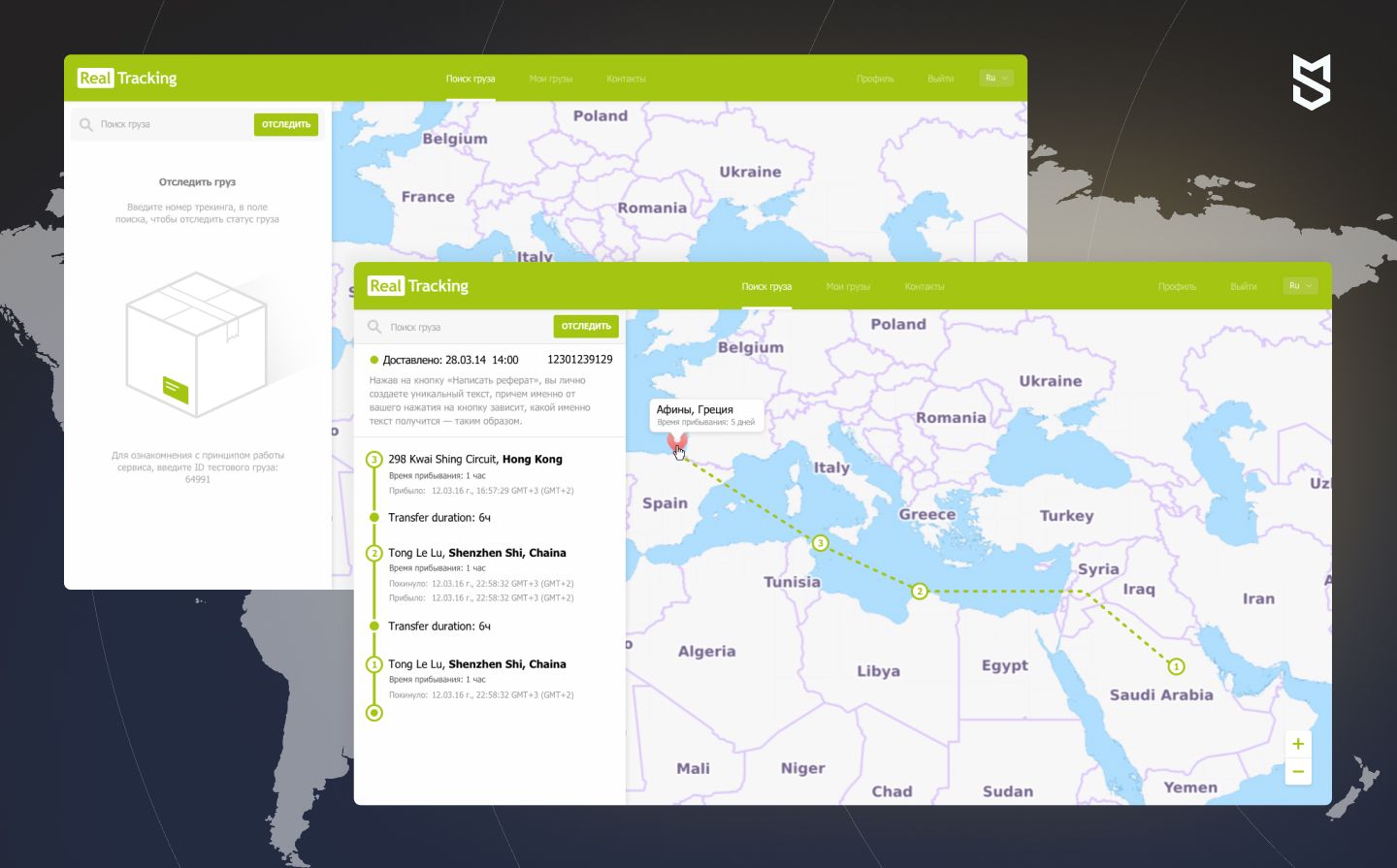
Our company has extensive experience in developing platforms for logistics and transportation businesses, including:
- Warehouse and inventory management systems
- Fleet management solutions
- On-demand delivery services
- Cargo transportation tracking systems
- Route planning and navigation solutions
To give you a more specific example of our work, here is an overview of one of Mind Studios’ projects for the logistics and transportation company.
M3Cargo is a Ukrainian cargo company that provides secure direct purchases of goods, raw materials, and equipment transported primarily from China and delivered to small and medium-sized European businesses. M3Cago helps its clients conduct procurement audits, reduce costs, and solve other logistics challenges.
The company also calculates the cost and time of the delivery services in advance and guarantees that the order will not be lost along the way. What is more, the company’s clients can track their orders in real time through an independent tracking service.
As you might have guessed, M3Cargo uses IoT devices to provide this functionality: each container delivered by the service has a GPS tracking device attached to it.
M3Cargo turned to Mind Studios to develop an app that would process data collected from those devices and enable tracking functionality for the customers to check the current status and location of their orders. The final product got the name Real Tracking.
Conclusion
Supply chains have always been vulnerable to various disruptions like resource leaks, damaged products, delays, and losses. Today, IoT technologies are successfully solving these problems — and even helping business owners prepare for the next challenges.
If you are thinking of integrating IoT technology into your business and looking for a reliable partner to develop user-friendly, efficient software solutions that will help you manage and apply the data you collect — Mind Studios has got you covered.
During a free consultation with our business development team, you will be able to ask any questions about software solutions for the supply chain and Internet of Things integration. Together we will find the most cost-effective solutions for your specific needs. Fill in a short contact form, and we will get back to you.

